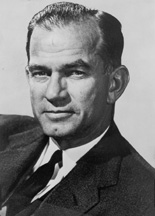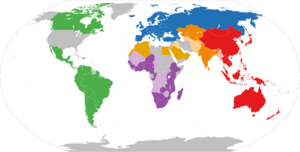Fulbright Program facts for kids
Quick facts for kids Fulbright Program |
|
|---|---|
 |
The Fulbright Program is a special exchange program. It helps people from the United States and other countries learn from each other. The main goal is to build better friendships and understanding between different cultures.
This program was started in 1946 by United States Senator J. William Fulbright. Many people see it as one of the best scholarships in the U.S.
Through Fulbright, talented people like students, teachers, and artists can get money to study, do research, or teach in other countries. People from other countries can also come to the U.S. to do the same. About 8,000 grants are given out each year.
The Fulbright Program works in over 160 countries. The Bureau of Educational and Cultural Affairs of the U.S. Department of State helps run it. Many countries also help fund the program. More than 370,000 people have been part of Fulbright. Many alumni have won big awards like the Nobel Prize and Pulitzer Prize.
Contents
History of the Fulbright Program

How the Program Started
The Fulbright Program's mission is to bring a little more knowledge, a little more reason, and a little more compassion into world affairs and thereby increase the chance that nations will learn at last to live in peace and friendship.
—Senator J. William Fulbright
After World War II, Senator J. William Fulbright had a great idea. He suggested using money from selling leftover U.S. war property. This money would fund international exchanges. The goal was to promote peace and understanding.
Congress agreed and created the Fulbright Program in August 1946. It became the largest education exchange program ever. Later, in 1961, the program grew even more. It started to support things like language training and cultural research.
The program works with each country individually. China was one of the first countries to join in 1947. Burma, the Philippines, and Greece followed in 1948.
Recent Challenges
In March 2024, the Fulbright Program in Russia ended. This happened when the Russian government declared some partner organizations "undesirable."
In February 2025, the U.S. government paused funding for some State Department programs. This included the Fulbright Program. This pause affected many participants.
In June 2025, some members of the Fulbright board resigned. They said there was political interference. They were worried about how awards were being chosen. This caused concern among educators and lawmakers.
What the Program Offers
Educational exchange can turn nations into people, contributing as no other form of communication can to the humanizing of international relations.
—Senator J. William Fulbright
The Fulbright Program helps students and scholars travel between countries. It has different programs for U.S. citizens going abroad. It also has programs for people from other countries coming to the U.S.
To get a Fulbright grant, you need good grades. You also need a strong project idea. Leadership skills and being able to adapt to new cultures are important too.
Fulbright grants are given for almost all school subjects. This includes arts, history, science, and math. The only exception is medical research that involves direct patient care.
Grants for Students
- The Fulbright Degree Program helps international students study in the U.S. They can get a Master's or Ph.D. degree.
- The Fulbright U.S. Student Program offers money to U.S. college students and young professionals. They can research, study, or teach English in another country for a year. This helps them learn about other cultures.
- The Fulbright Foreign Student Program helps students and artists from other countries. They can do research and study in the United States.
- The Fulbright Foreign Language Teaching Assistant Program helps young English teachers from other countries. They improve their teaching skills in the U.S. They also help teach foreign languages at U.S. colleges.
- The Fulbright-mtvU Fellowships let U.S. students study music as a cultural force abroad. They share their experiences through videos and blogs.
- The Fulbright-Clinton Fellowship allows U.S. students to work in foreign government offices. This gives them real-world experience.
| Top 10 Universities Producing Scholars | Scholars (all-time) | Scholars (since 2005) |
|---|---|---|
| Harvard University | 1,450 | 410 |
| Yale University | 1,208 | 372 |
| University of California, Berkeley | 1,002 | 306 |
| Columbia University | 1,001 | 327 |
| University of Michigan | 939 | 450 |
| Princeton University | 896 | 299 |
| Stanford University | 809 | 289 |
| University of Wisconsin–Madison | 805 | 225 |
| University of Chicago | 769 | 354 |
| Brown University | 716 | 391 |
Grants for Scholars
- The Fulbright Distinguished Chair Awards are for top scholars. They can lecture or do research for several months. These are very important awards.
- The Fulbright U.S. Scholar Program sends U.S. professors and experts abroad. They can teach or do research for up to a year.
- The Fulbright Specialist Program sends U.S. experts to other countries. They help universities with things like teaching plans. This usually lasts a few weeks.
- The Fulbright Visiting Scholar Program brings foreign scholars to the U.S. They can teach or do research at U.S. colleges.
Grants for Teachers
- The Fulbright Teacher Exchange Program helps teachers from kindergarten to high school. They can swap places with teachers in other countries.
- The Distinguished Fulbright Awards in Teaching Program sends teachers abroad. They work on projects and lead classes for a semester.
Grants for Professionals
- The Hubert H. Humphrey Program brings professionals from developing countries to the U.S. for a year. They study and gain work experience.
Fulbright–Hays Program
The Fulbright–Hays Program is part of Fulbright. It is funded by the U.S. Department of Education. It gives grants to U.S. teachers, students, and universities. This program focuses on learning foreign languages and studying different areas of the world.
For example, the Fulbright–Hays Doctoral Dissertation Research Abroad helps students do research in other countries. The Fulbright–Hays Seminars Abroad lets U.S. educators travel in groups. They learn about other cultures and create new lessons for their students.
How the Program is Managed
The Fulbright Program is managed by the Bureau of Educational and Cultural Affairs (ECA). This is a part of the United States Department of State. A special board, the Fulbright Foreign Scholarship Board (FSB), sets the rules.
Many countries have a bi-national Fulbright Commission. These commissions are funded by both the U.S. and the partner country. They help choose candidates and support the people who come to their country. If a country doesn't have a commission, the U.S. Embassy helps run the program there.
Organizations like the Institute of International Education also help. They manage different parts of the program.
Fulbright Alumni Groups
There are groups for people who have been part of the Fulbright Program. These groups are independent. They help former participants stay connected. They also share how important international exchange is.
The Fulbright Association is one such group in the U.S. There are also alumni groups in over 75 countries. The Fulbright Academy focuses on alumni in science and technology.
Fulbright Prize for International Understanding
The J. William Fulbright Prize for International Understanding is a special award. It honors people or groups who have done amazing things to help different cultures understand each other. It started in 1993. The first winner was Nelson Mandela.
| Person | Year | Country |
|---|---|---|
| Nelson Mandela | 1993 | South Africa |
| Jimmy Carter | 1994 | United States |
| Franz Vranitzky | 1995 | Austria |
| Corazon Aquino | 1996 | Philippines |
| Václav Havel | 1997 | Czech Republic |
| Patricio Aylwin | 1998 | Chile |
| Mary Robinson | 1999 | Ireland |
| Martti Ahtisaari | 2000 | Finland |
| Kofi Annan | 2001 | Ghana |
| Sadako Ogata | 2002 | Japan |
| Fernando Henrique Cardoso | 2003 | Brazil |
| Colin Powell | 2004 | United States |
| Bill Clinton | 2006 | United States |
| Desmond Tutu | 2008 | South Africa |
| Bill and Melinda Gates Foundation | 2010 | United States |
| Médecins Sans Frontières | 2012 | France |
| Hans Blix | 2014 | Sweden |
| Richard Lugar | 2016 | United States |
| Angela Merkel | 2018 | Germany |
| Bono | 2021 | Ireland |
| Kizzmekia Corbett, Anthony Fauci | 2022 | United States |
| Gary White, Matt Damon | 2024 | United States |
| Christiane Amanpour | 2025 | United Kingdom |
Famous Fulbright Alumni
Many Fulbright alumni have become leaders in different fields.
- 89 have won the Pulitzer Prize.
- 62 have received a Nobel Prize.
- 40 have been a head of state or government.
- 10 have served in the U.S. Congress.
- 1 has been the secretary general of the United Nations.
Some well-known Fulbright alumni include:
- Edward Albee, a famous playwright
- John Ashbery, a poet
- Boutros Boutros-Ghali, former United Nations Secretary-General
- Fernando Henrique Cardoso, former president of Brazil
- Dale Chihuly, a glass artist
- Aaron Copland, a composer
- Rita Dove, a U.S. Poet Laureate
- Ashraf Ghani, former president of Afghanistan
- Gabby Giffords, a U.S. politician
- John Lithgow, an actor
- Dolph Lundgren, an actor
- Linus Pauling, a Nobel Prize winner in Chemistry and Peace
- Sylvia Plath, a poet
- Maria Ressa, a Nobel Peace Prize winner
- Juan Manuel Santos, former president of Colombia and Nobel Peace Prize winner
- Wallace Shawn, an actor and playwright
- Joseph Stiglitz, a Nobel Prize winner in Economics
- Rishi Sunak, the Prime Minister of the United Kingdom
- Muhammad Yunus, a Nobel Peace Prize winner
See also
 In Spanish: Programa Fulbright para niños
In Spanish: Programa Fulbright para niños
- Academic mobility
- Cultural diplomacy
- Erasmus Programme
- Rhodes Scholarship


